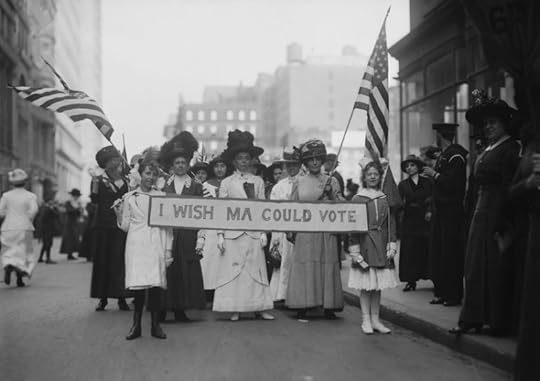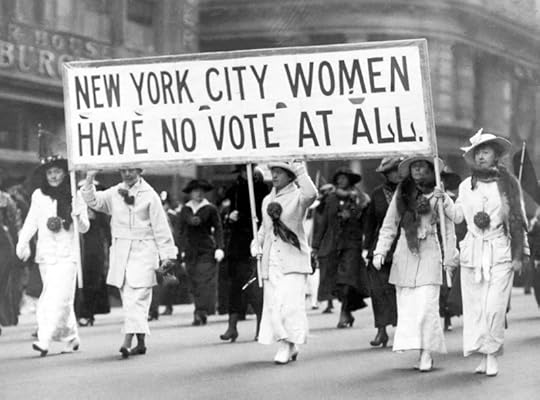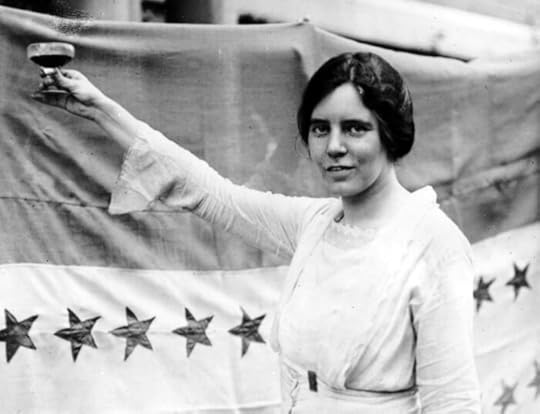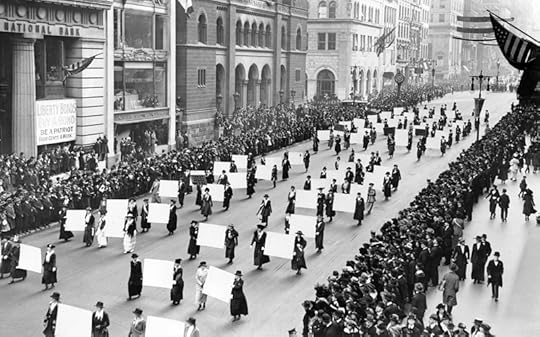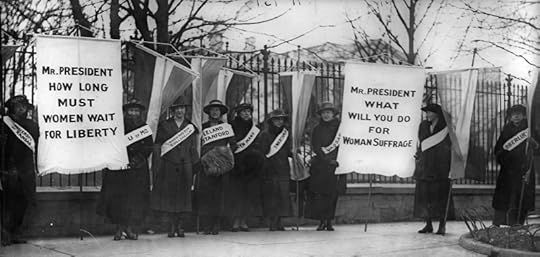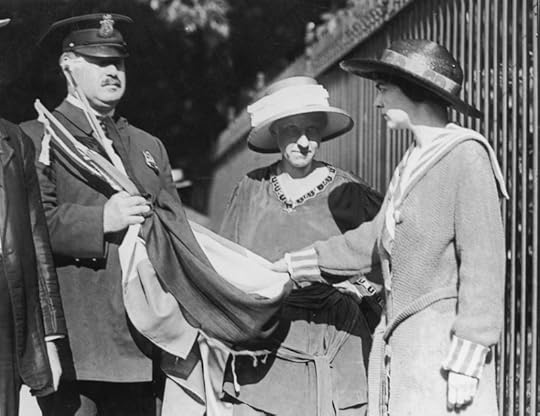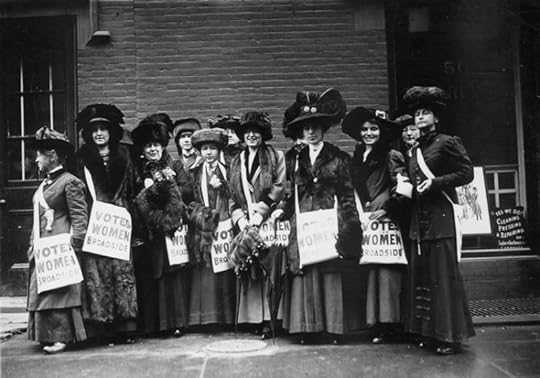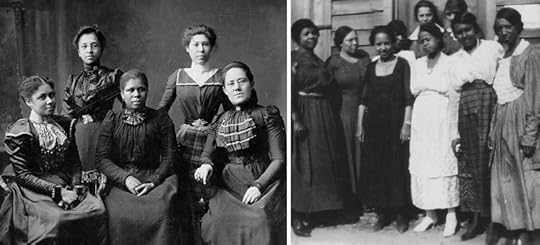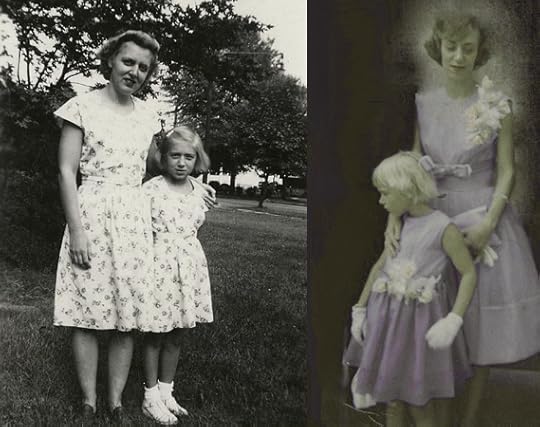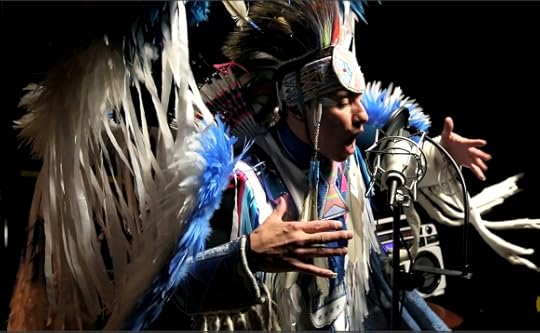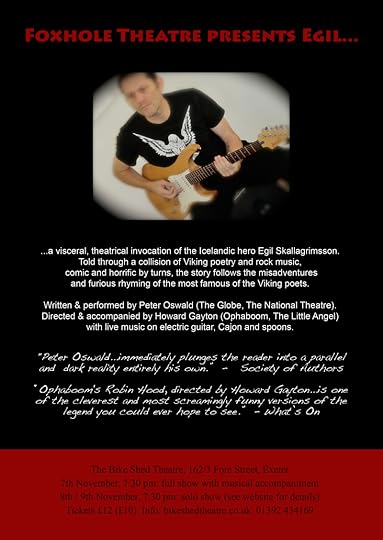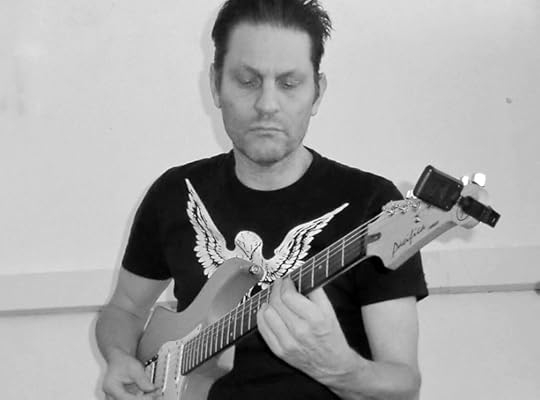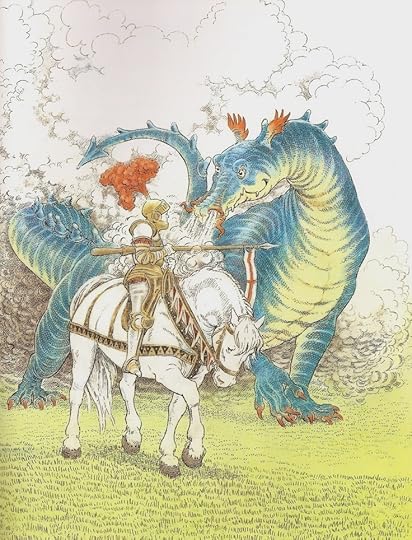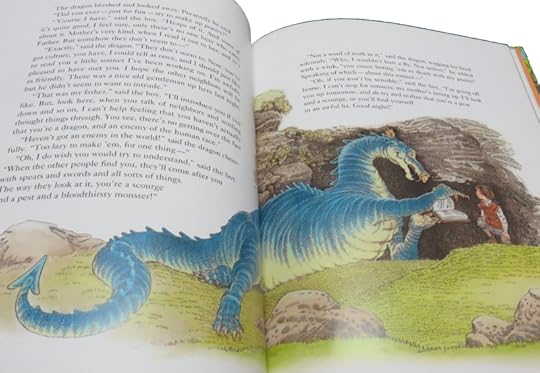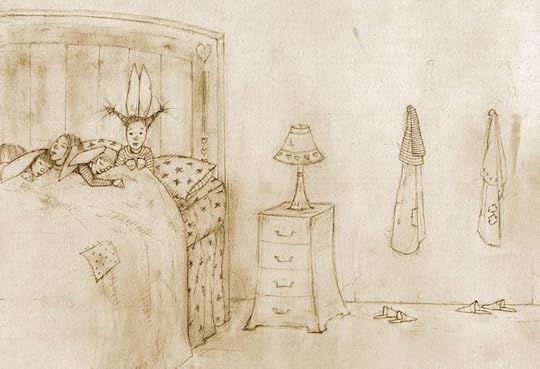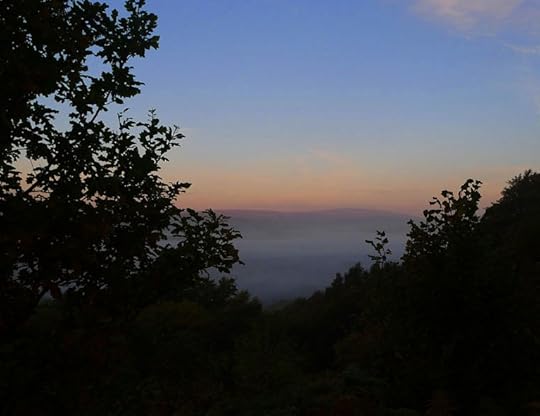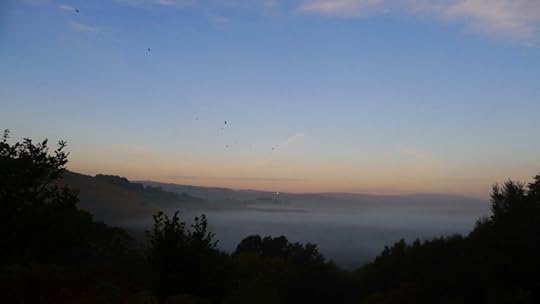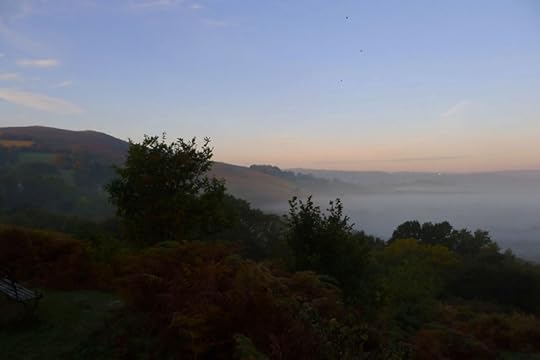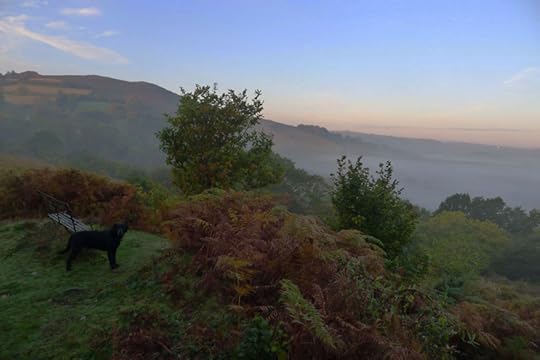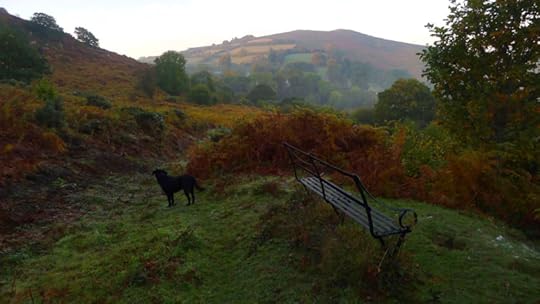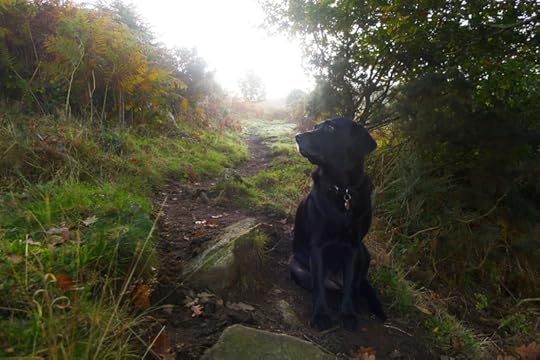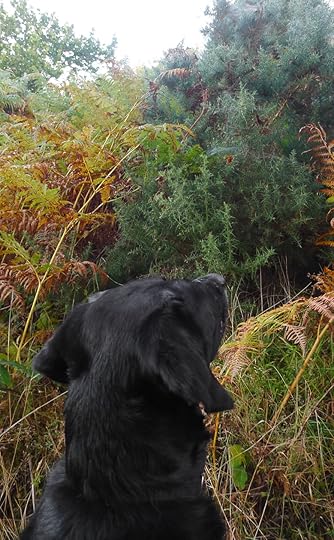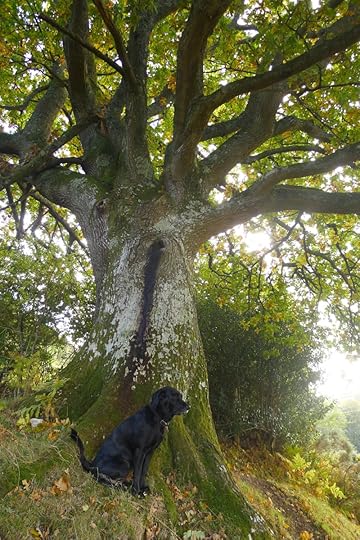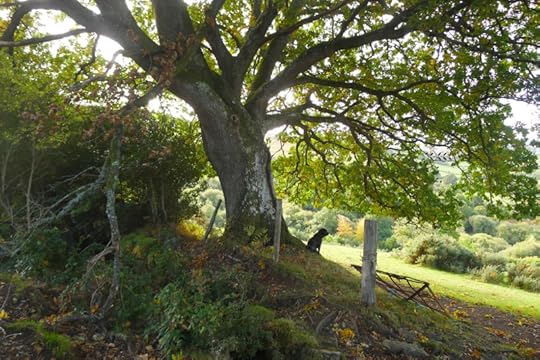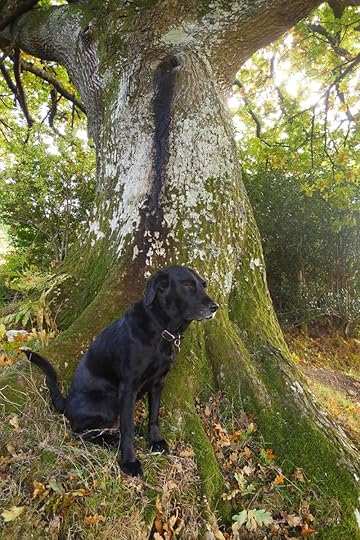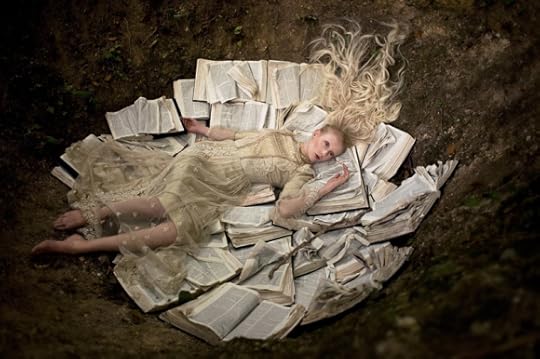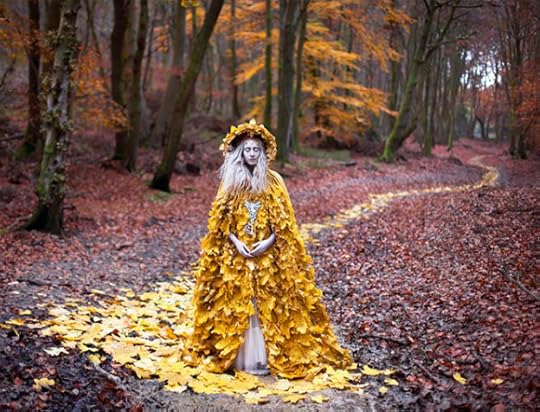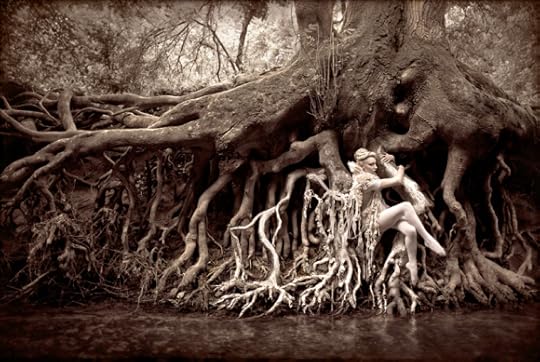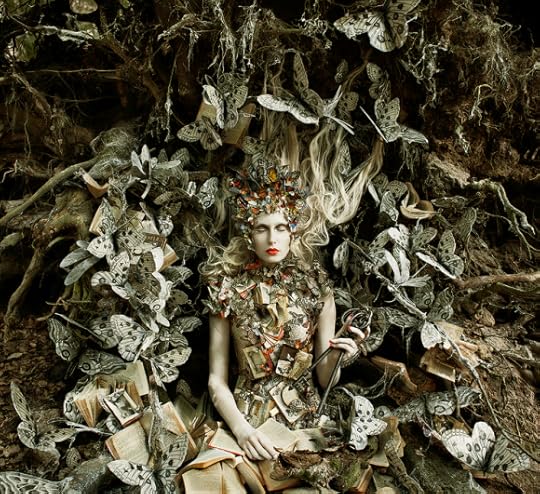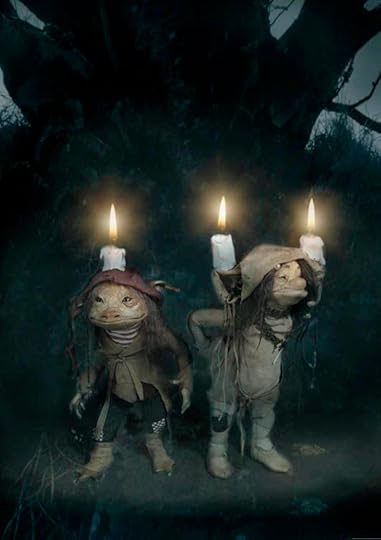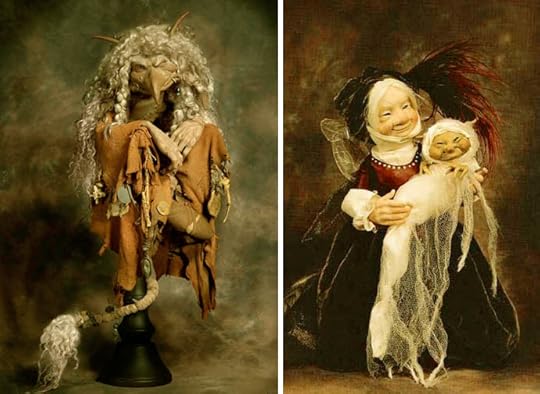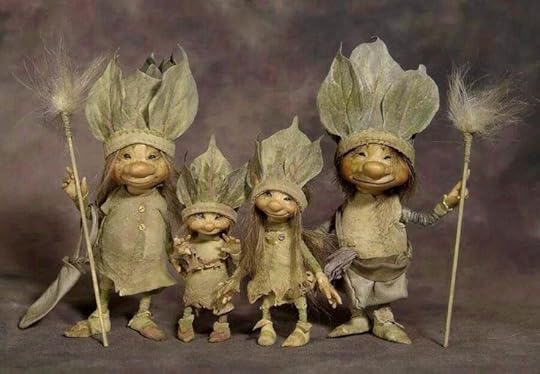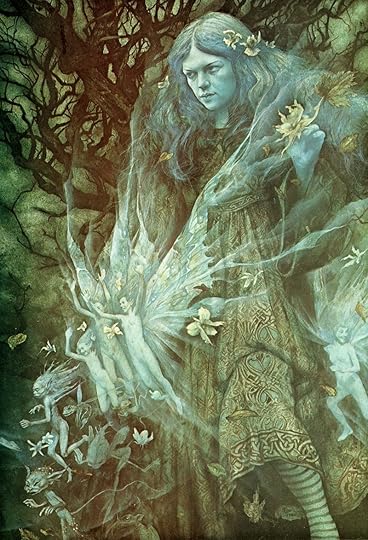Terri Windling's Blog, page 103
November 8, 2016
Election Day
The U.S. election is today (thank heavens, for how much more of this could we take?), and the historic nature of it keeps disappearing beneath the media circus of it all. Wherever you fall on the political spectrum, and whatever you think of the two candidates, let's please taking a moment to appreciate the history-making fact that there is, finally, a viable female candidate on the presidential ballot.
When my grandmother was born, women could not vote; the 19th Amendment giving us that right wasn't signed into law until 1920. When my mother was born, it was still legal to deny us jobs, housing, banking service, mortgages, and the power to make our own health care decisions; the first laws addressing these issues weren't signed until the 1960s. When I was born, it was still legal for a man to rape his wife in all 50 states; the first state law against it wasn't signed until 1973. We've come a long way, baby...and, sadly, we have not come nearly far enough, as the depth of the misogyny unleashed during the campaign season we've just endured has surely made clear.
Today, there are women in America wearing white as they head to the voting booth, in honor of the Suffragists who fought so hard to give us this right. Although I've already voted with a mail-in ballot, I'm wearing white here in Devon too. While I am, of course, praying that we'll see a woman in the White House at the end of this process, we're making history today regardless of the outcome. Women have run for president before, but never as a major party nominee, and never with a chance in hell of succeeding. It shouldn't have taken this long, it shouldn't have been this hard, but we're finally here.
For women of my generation (and older), this is more momentous than some of our younger feminist sisters and brothers can perhaps conceive. The world that we were born into was very different from today.
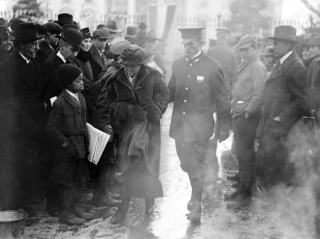 "When I was a girl of 11," writes novelist Barbara Kingsolver in The Guardian, "I had an argument with my father that left my psyche maimed. It was about whether a woman could be the president of the US.
"When I was a girl of 11," writes novelist Barbara Kingsolver in The Guardian, "I had an argument with my father that left my psyche maimed. It was about whether a woman could be the president of the US.
"How did it even start? I was no feminist prodigy, just a shy kid who preferred reading to talking; politics weren���t my destiny. Probably, I was trying to work out what was possible for my category of person -- legally, logistically -- as one might ask which kinds of terrain are navigable for a newly purchased bicycle. Up until then, gender hadn���t darkened my mental doorway as I followed my older brother into our daily adventures wearing hand-me-down jeans. But in adolescence it dawned on me I���d be spending my future as a woman, and when I looked around, alarm bells rang. My mother was a capable, intelligent, deeply 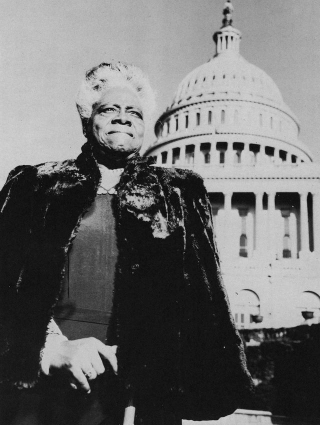 unhappy woman who aspired to fulfilment as a housewife but clearly disliked the job. I saw most of my friends��� mothers packed into that same dreary boat. My father was a country physician, admired and rewarded for work he loved. In my primordial search for a life coach, he was the natural choice.
unhappy woman who aspired to fulfilment as a housewife but clearly disliked the job. I saw most of my friends��� mothers packed into that same dreary boat. My father was a country physician, admired and rewarded for work he loved. In my primordial search for a life coach, he was the natural choice.
"I probably started by asking him if girls could go to college, have jobs, be doctors, tentatively working my way up the ladder. His answers grew more equivocal until finally we faced off, Dad saying, 'No' and me saying, 'But why not?' A female president would be dangerous. His reasons vaguely referenced menstruation and emotional instability, innate female attraction to maternity and aversion to power, and a general implied ickyness that was beneath polite conversation.
"I ended that evening curled in bed with my fingernails digging into my palms and a silent howl tearing through me that lasted hours and left me numb. The next day I saw life at a remove, as if my skull had been jarred. What changed for me was not a dashing of specific hopes, but an understanding of what my father -- the person whose respect I craved -- really saw when he looked at me. I was tainted. I would grow up to be a lesser person, confined to an obliquely shameful life."
I, too, had that conversation -- not with my father (I didn't have one), but with my grandmother; and not, I blush to confess, about any such lofty ambition as becoming president. What I wanted was to be a radio DJ like Cousin Brucie, whose New York-based show, full of British pop music and Motown, I listened to religiously. I must have been six or seven when my grandmother sat me down and explained that, being a girl, this would be impossible. Girls, she said, could be housewives, teachers, nurses, or secretaries, and that was pretty much it.
It was only then that I realized that, no, there were no women on any of the radio shows I listened to, or in any of the other wide-ranging jobs I fantasized about holding one day. I mean no disrepect towards teachers, nurses, secretaries, or stay-at-home parents; there are awesome women and men in all those roles, but those weren't the things I was dreaming of. My jobs of choice were DJ, explorer, motorcycle racer, artist or veterinarian (pretty much in that order). And like Barbara, I went to sleep that night in tears, feeling the world collapse around me.
I know little about my grandmother's politics, as it wasn't a subject we talked about. But as I grew older, my mother -- a soft-spoken, unrebellious kind of woman -- became a passion supporter of equal rights, aware her own life had been unhappily constrained by traditional gender scripts. She worked hard, with few leisure hours, and yet she made time to volunteer for her local branch of the League of Women Voters, fighting past the shyness she felt as a working class woman in a middle class organization (or so it was her neighborhood) because of her conviction that women must use the vote to gain equality and independence.
My mother died fifteen years ago, but as I sat down at my kitchen table with my overseas ballot and checked the box by Hillary Clinton's name, I found myself feeling surprisingly emotional. I completed the form, sealed the envelope, and said out loud:
"This one's for you, mom."
Good luck today, America. May the best woman win.
Video above: "Bad Romance: Women���s Suffrage," a fabulous parody of Lady Gaga's "Bad Romance." Released by Soomo Publishing in 2012, the video is "an homage to Alice Paul and the generations of brave women who joined together in the fight to pass the 19th Amendment."
Photograph above: My grandmother & my mother, 1940s. My mother & me, 1960s.
November 7, 2016
Tunes for a Monday Morning
Today's music is from the new generation of Native American/Canadian musicians, mixing traditional rhythms with hiphop, electronica, pop, jazz, and more. This post is dedicated to the courageous pipeline protesters at Standing Rock, with prayers for them, for all of their supporters, and for the ones who stand against them, so that hearts might soften and minds might change.
Above, a film about the work young First Nations artists and activists are doing today: "Rebel Music/Native America: 7th Generation Rises," by Nusrat Durrani with Shepard Fairey, David Sable, and music director Laura Jane Grace.
Below, "Stadium Pow Wow" by A Tribe Called Red, from their latest album, We Are The Halluci Nation (2016). A Tribe Called Red comes out of the urban Native dance scene in Ottowa, Ontario. The group consists of Ian Campeau (of the Nipissing First Nation), Tim Hill (Mohawk, of the Six Nations of the Grand River), and Bear Witness (of the Cayuga First Nation).
Above, "My Stone," a poignant song by Frank Waln (2014). Waln, a.k.a. Oyate Teca Obmani (Walks With Young People), is a Sicangu Lakota hiphop artist, producer, and performer from the Rosebud Reservation in South Dakota. I love this young man's work.
Below, "Dancing on the Run" by Inez Jasper, an Ojibway/M��tis heritage singer/songwriter from British Columbia. Jasper uses pop music to address the ways tribal dances and ceremonies were outlawed by the Canadian & American governments in the not-too-distant past...and it does so with humor and infectious joy.
Above, "Why" by Supaman (Christian Parrish), an Aps��alooke hiphop musician and fancy dance champion from Seattle, Washington. In this video, he teams up with jingle dance champion Acosia Red Elk, from the Umatilla people of the Pacific Northwest, to create a prayer of sound and movement.
Below (as a nod to tomorrow's nail-biter of an election in the U.S.), "Me and Mr. Washington" by the wonderfuk Nahko Bear and his band, Medicine for the People. Nahko is a singer/songwriter of mixed Apache, Mohawk, Puerto Rican & Filipino heritage. He was raised in Oregon, now lives in Hawaii, and is active in the Earth Guardians movement of young artists and activists.
November 6, 2016
Viking Slam Poetry....
Due to being under the weather with flu this past week I've been remiss in letting you know that my husband, Howard Gayton, and his theatre partner, Peter Oswald. have a performance at the Bike Shed Theatre in Exeter this week. If you're anywhere near Exeter, please come! The show is tomorrow (Monday) night, at 7:30, and it would be lovely to see some of you from the Mythic Arts community there.
For Mythic Arts fans, Egil is right up our alley for it's based on an old Icelandic saga of a Viking warrior and poet. Written & performed by Peter, with music & direction by Howard, the show is unlike anything you'll ever have seen before -- for it seems to me that they are basically inventing a new genre in this and other works that they have on the boil. Peter calls it "poetry performance." I'll let him explain:
"At the moment," he says, "live poetry falls into a few recognised categories. There is ���page poetry,��� which is read by a poet from a book to an audience. This is contrasted with ���stage poetry,��� also known as ���performance poetry,��� which is learned by heart and performed. Performance poetry usually has a relation to rap or hip hop -- fast, rhyming, political, personal and urban. Then there is storytelling, which sometimes takes the form of poetry, rhyming or unrhyming, sometimes with musical accompaniment. All these come into the category of ���spoken word,��� except perhaps the page poetry.
"There are many other modes, no doubt," Peter continues, "but these are a few I know about. Generally speaking, in order to be recognised as a serious poet, you have to be a 'page poet��� and do deadpan expressionless readings from a book. (There are exceptions, like my wife, Alice.) Doing a performance last year with a page poet, there was a moment when I was describing what I was going to do and he looked at me in genuine dismay and said, ���You���re not an actor are you?��� 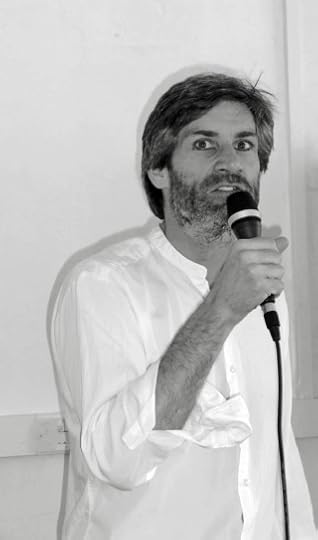 Similarly, recently in Plymouth, as part of the Literature Festival, I did a performance of a few of my sonnets, followed by a performance -- with actions, different voices, even a small dance -- of my poem Helen. Afterwards, the organiser, delighted but genuinely baffled, asked me, ���So...do you have a background in theatre???���
Similarly, recently in Plymouth, as part of the Literature Festival, I did a performance of a few of my sonnets, followed by a performance -- with actions, different voices, even a small dance -- of my poem Helen. Afterwards, the organiser, delighted but genuinely baffled, asked me, ���So...do you have a background in theatre???���
"A combination that���s not readily understood is a poet who is an actor performing stories that are poems. This is what I call 'poetry performance.' Prior to this, I���ve pursued it on my own -- but now, working with Howard, the category is stepping over the line between poetry and theatre. This is the real difference between poetry performance and performance poetry. Performance poetry has no real crossover with theatre; it���s more related to standup. But poetry performance, as Howard and I practice it, has deep roots in theatre.
"We think of Homer���s works as the highest poetry, and yet they are stories designed to be performed with music. If you do that nowadays you are a storyteller, not a poet. This confusion is caused by the dominance of one kind of book poetry. We are challenging this with Egil."
November 4, 2016
The dragons in our lives, and in the world
I'm still under the weather, but popping in just long enough to post the following words by Rainer Maria Rilke. I was feeling in need of them today, and perhaps you are too....
In Letters to a Young Poet, he writes: "How should we be able to forget those ancient myths that are at the beginning of all peoples, the myths about dragons that at the last moment turn into princesses; perhaps all the dragons in our lives are princesses who are only waiting to see us act, just once, with beauty and courage. Perhaps everything that frightens us is, in its deepest essence, something helpless that wants our love."
The illustration is by Inga Moore, from "The Reluctant Dragon" by Kenneth Grahame.
November 3, 2016
Myth & Moor update
November 1, 2016
Sunrise on Nattadon Hill
From an interview with Terry Tempest Williams in Guernica magazine:
"Finding beauty in a broken world is creating beauty in the world we find. For me, we find this beauty through relationships, with people in place with other species. Integrity is the word that comes to mind. Integrity and presence.
"A friend of mine said to me not long ago, 'Terry you are married to sorrow.' I looked at him and said, 'No, I am not married to sorrow, I just choose not to look away.' To not avert our eyes to suffering is to trust the power of presence. Joy emerges through suffering. Suffering is a component of joy. Whether we are sitting with a loved one dying or witnessing dolphins side-by-side watching the oil burning in the Gulf of Mexico, to be present with the world is to be alive. I think of Rilke once again, 'Beauty is the beginning of terror.' We can breathe our way toward courage.
"When we were working in the village of Rugerero with Rwandan women who had lost everything from war, I saw a light in their eyes return when their children began picking up paintbrushes and painting the walls of their homes. Joy entered in. Creativity ignited a spark. In that moment, I saw that art is not peripheral, beauty is not optional, but a strategy for survival.
"In Rwanda, USAID was saying, 'How can you dare to paint a village when people are hungry?' But beauty feeds a different kind of hunger. And when there���s so much ugliness in the world that we���ve created, I think it���s essential, that whether it���s pausing in a garden with a trowel in hand, or walking up to Delicate Arch in Arches National Park, or picking up a paintbrush with children, our soul seizes beauty and is sustained.
"Finding beauty in a broken world is acknowledging that beauty leads us to our deepest and highest selves. It inspires us. We have an innate desire for grace. It���s not that all our definitions of beauty are the same, but when you see a particular heron in the bend in the river, day after day, something in your soul stirs. We remember what it means to be human."
Under the old oak
It's one more week until the U.S. election. For this and too many other reasons the Internet feels like one giant howl of anxiety, anguish, and rage....
And what I've been thinking about lately is silence. There is not enough silence in modern life. I don't mean the complete absence of sound, but those quiet moments when the human world recedes: the haranguing voices of the daily news, the ads that follow us shouting Look at me!, the commercial and cultural sound and fury that makes it hard to hear our own inner voice, our own inner music, or our own heart beating, much less the beating heart of the natural world that we share with our nonhuman neighbors.
I have begun the practice of beginning my days in silence (no Internet, no music on the stereo, not even a book to read) while I drink my first morning cup of coffee...often outdoors, if the weather permits, underneath the old oak pictured here, or in the woods, or another favorite spot close to the studio. Or else indoors, by a window looking out at the birds, the weather, the land. Watching and listening. It slows me down; sets the tone for the day ahead; roots me in the actual world and not the fickle, transitory realm of cyberspace. It prepares me for the deep work of creating by honing the sharp instrument my attention.
If I could gift you with one thing in the anxious week ahead, it would be this. Silence. Blessed silence.
"Why is silence important to writers?" Lorraine Berry asked Utah-based writer Terry Tempest Williams in an interview in 2013. "Is silence something that we all, regardless of whether we���re writers or not, need access to? And how do we find that in our increasingly tuned-in, turned-on world?"
"Silence is where we locate our voice," Williams answered, "both as writers and as human beings. In silence, the noises outside cease so the dialogue inside can begin. Silence takes us to an unknown place. It���s not necessarily a place of comfort. For me, the desert holds this space of quiet reflection; it���s erosional, like the landscape itself.
"You also ask why is it important that writers write and not embrace a life of silence. In many ways, we do embrace a lifestyle of silence, inward silence, a howling silence that brings us to our knees and desk each day. All a writer really has is time. Time to think. Time to read. Time to write.
"Time for a writer translates into solitude. In solitude, we create. In solitude, we are read. If we���re lucky, our books create community having been written out of solitude. It���s a lovely paradox. It���s the creative tension that I live with: I write to create community, but in order to do so, I am pulled out of community. Solitude is a writer���s communion."
October 31, 2016
Tunes for a Monday Morning
I'd been thinking of chosing darkly gothic music for today in honor of Halloween...but in truth, the world seems plenty dark already. For me, ghosts and ghouls lose their appeal when the daily news provides nightmares enough. Instead, here are three songs full of light to keep us going during troubled times.
First, above: "Receive" by The Danberrys (Ben DeBerry & Dorothy Daniel), an American roots duo from Nashville, Tennessee. This performance by The Danberrys and friends was filmed in Nashville a few months ago.
Second, below: "Beauty in these Broken Bones," a gospel tune from Red Moon Road and friends, filmed in Winnipeg, Mantibo in 2014. Red Moon Road is a Canadian alt-folk trio consisting of Sheena Rattai, Daniel P��loquin-Hopfner, and Daniel Jordan. Their three albums mix original tunes with traditional songs in both English and French.
And last, below: a beautiful performance of "Seasons" by Red Moon Road and friends in Winnipeg earlier this year. It comes from their fine third album, Sorrows and Glories (2015).
The magical images today are by English artist, designer & photographer Kristy Mitchell.
"My earliest memories were always of the stories read to me by my mother as a child," she says, "how it felt to be curled into her side, listening to the rush of her breath as she paused for effect, before launching into yet another characters voice. She was an English teacher, and read to me almost everyday, to an age I could no longer admit to my friends. She instilled in me the most precious gift a mother could, her imagination and a belief in beauty, it became my root, and the place I constantly try to return to in my work, and my dreams."
October 30, 2016
Candle trolls and seasonal tales
Happy Halloween, everyone!
To get the day started off right, I recommend "Samhain, Death and The Cailleach," a wise and lovely post by my friend & neighbor Suzi Crockford.
If you're in the mood for spooky folklore, you'll find some in these previous posts: The Wild Hunt, Following the Hare, and The Dark Forest ... plus in the two pieces I posted last week: At the Death of the Year and Death in Folk & Fairy Tales.
For music to play by the Samhain fire, try these two terrific podcasts from Tamsin Rosewell's Folk Show on Radio Warwickshire: "Phantasmagoria: folk songs of ghosts, spirits, and hauntings" and "The Old Stories: magic, ritual, and pre-Christian belief."
And for a taste of the living folklore tradition here in the West Country, visit Beltane Border Morris's FB page for videos of the Samhain procession, Obby Oss, and lots of earthy Border Morris dancing in Boscastle, Cornwall.
The photographs above and below are of sculptures made by another friend & neighbor, Wendy Froud. "I feel that my work is a sign post to the half forgotten world that we all carry inside of us," she says. "When people look at my work, I want them to think , 'Oh, now I remember.' If they do that, then I know that my artwork has been successful."
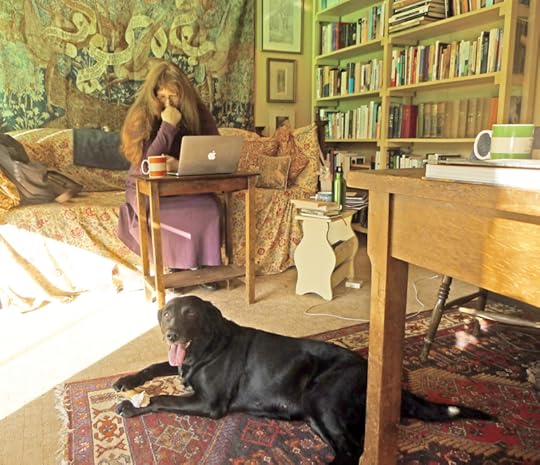 Wendy on a "writing day" in my studio (we sometimes work together), while Tilly looks on.
Wendy on a "writing day" in my studio (we sometimes work together), while Tilly looks on.
October 28, 2016
From the archives: At the Death of the Year
In Celtic lore, October 31st is Samhain (All Hallow's Eve, or Halloween): the night when Arawn, lord of the Dead, rides the hills with his ghostly white hounds, and the Faery Court rides forth in stately procession across the land. In ancient times, hearth fires were smothered while bonfires blazed upon the hills, surrounded by circular trenches to protect all mortals from the faery host and the wandering spirits of the dead. In later centuries, Halloween turned into a night of revels for witches and gouls, eventually tamed into the modern holiday of costumes, tricks and treats.
Although the prospect of traffic between the living and the dead has often been feared, some cultures celebrated those special times when doors to the Underworld stood open. In Egypt, Osiris (god of the Netherworld, death, and resurrection) was drowned in the Nile by his brother Seth on the 17th of Athyr (November); each year on this night dead spirits were permitted to return to their homes, guided by the lamps of living relatives and honored by feasts. In Mexico, a similar tradition was born from a mix of indigenous folk beliefs and medieval Spanish Catholism, resulting in los Dias de Muertos (the Days of the Dead) -- a holiday 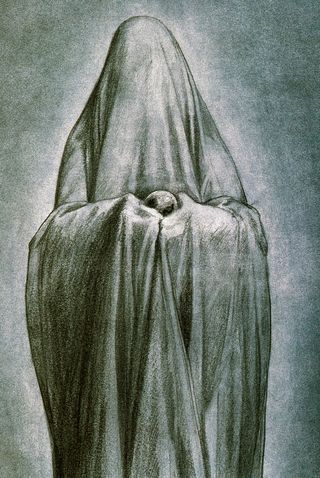 still widely observed across Mexico and parts of the American South-West. The holiday varies from region to region but generally take place over the days of October 31st, November 1st, and November 2nd, celebrated with graveyard gatherings and Carnival-like processions in the streets. Within the house, an ofrenda or offering is painstakingly assembled on a lavishly decorated altar. Food, drink, clothes, tequila, cigarettes, chocolates and children's toys are set out for departed loved ones, surrounded by candles, flowers, palm leaves, tissue paper banners, and the smoke of copal incense. Golden paths of marigold petals are strewn from the altar to the street (sometimes all the way to the cemetary) to help the confused souls of the dead find their way back home.
still widely observed across Mexico and parts of the American South-West. The holiday varies from region to region but generally take place over the days of October 31st, November 1st, and November 2nd, celebrated with graveyard gatherings and Carnival-like processions in the streets. Within the house, an ofrenda or offering is painstakingly assembled on a lavishly decorated altar. Food, drink, clothes, tequila, cigarettes, chocolates and children's toys are set out for departed loved ones, surrounded by candles, flowers, palm leaves, tissue paper banners, and the smoke of copal incense. Golden paths of marigold petals are strewn from the altar to the street (sometimes all the way to the cemetary) to help the confused souls of the dead find their way back home.
According to Fredy Mendez, a Totonac man from Veracruz: "Between 31 October and 2 November, past generations were careful always to leave the front door open, so that the souls of the deceased could enter. My grandmother was constantly worried, and forever checking that the door had not been shut. Younger people are less concerned, but there is one rule we must obey: while the festival lasts, we treat all living beings with kindness. This includes dogs, cats, even flies or mosquitoes. If you should see a fly on the rim of a cup, don't frighten it away -- it is a dead relative who has returned. The dead come to eat tamales and to drink hot chocolate. What they take is vapor, or steam, from the food. They don't digest it physically: they extract the goodness from what we provide. This is an ancient belief. Each year we receive our relatives with joy. We sit near the altar to keep them company, just as we would if they were alive. At midday on 2 November the dead depart. Those who have been well received go laden with bananas, tamales, mole and good things. Those who have been poorly received go empty handed and grieving to the grave. Some people here have even seen them, and heard their lamentations."
(Go here for Stu Jenks' Guest Post on the Day of the Dead festivities in Tucson, Arizona.)
In Greek mythology, Persephone regularly crosses the border between the living and the dead, dwelling half the year with her mother (the goddess Demeter) in the upper world, and half the year with her husband (Hades) in the realm of the dead below. In another Greek story, Orpheus follows his dead wife deep into Hades' realm, where he bargains for her life in return for a demonstration of his musical skills. Hades agrees to release the lovely Eurydice back to Orpheus, provided he leads his wife from the Underworld without looking back. During the journey, he cannot hear his wife's footsteps and so he breaks the taboo. Eurydice vanishes and the pathway to Land of the Dead is closed. A similar tale is told of Izanagi in Japanese lore, who attempts to reclaim his beloved Izanami from the Land of Shadows. He may take her back if he promises not to try to see Izanami's face -- but he breaks the taboo, and is horrified to discover a rotting corpse.
When we look at earlier Sumarian myth, we find the goddess Inana is more successful in bringing her lover, Dumuzi, back from the Underworld; in Babylonian myth, this role falls to Ishtar, rescuing her lover Tammuz: "If thou opens not the gate," she says to the seven gatekeepers of the world below, "I will smash the door, I will shatter the bolt, I will smash the doorpost, I will move the doors, I will raise up the dead, eating the living, so that the dead will outnumber the living." During the three days of Ishtar's descent, all sexual activity stops on earth. The third day of the drama is the Day of Joy, the time of ascent, resurrection and procreation, when the year begins anew.
Coyote, Hermes, Loki, Uncle Tompa and other Trickster figures from the mythic tradition have a special, uncanny ability to travel between mortal and immortal realms. In his brilliant book Trickster Makes This World: Michief, Myth, & Art, Lewis Hyde explains that Trickster is the lord of in-between:
"He is the spirit of the doorway leading out, and the crossroads at the edge of town. He is the spirit of the road at dusk, the one that runs from one town to another and belongs to neither. Travellers used to mark such roads with cairns, each adding a stone to the pile in passing. The name Hermes once meant 'he of  the stone heap,' which tells us that the cairn is more than a trail marker -- it is an altar to the forces that govern these spaces of heightened uncertainty. The road that Trickster travels is a spirit road as well as a road in fact. He is the adept who can move between heaven and earth, and between the living and the dead."
the stone heap,' which tells us that the cairn is more than a trail marker -- it is an altar to the forces that govern these spaces of heightened uncertainty. The road that Trickster travels is a spirit road as well as a road in fact. He is the adept who can move between heaven and earth, and between the living and the dead."
Trickster is one of the few who passes easily through the borderlands. The rest of us must confront the guardians who rise to bar the way: the gods, faeries, and supernatural spirits whose role is to help or hinder our passage over boundaries and through gates, thresholds, and liminal states of mind. In folk tales, guardians can be propitiated, appeased, outwitted, even slain -- but often at a price which is somewhat higher than one really wants to pay.
On Samhain, we cross from the old year to the new -- and that moment of crossing, as the clock strikes the midnight hour, is a time of powerful enchantment. For a blink of an eye we stand poised between two years, two tales, two worlds; between the living and the dead, the mortal and the fey. We must remember to give food to Hecate, wine to Janus, and flowers, songs, smoke, and dreams to the gate-keepers along the way. Shamans, mythic artists, and fantasy writers: they all cast paths of spells, stories, and marigold petals for us to follow, keeping us safe until the sun rises and the world begins anew.
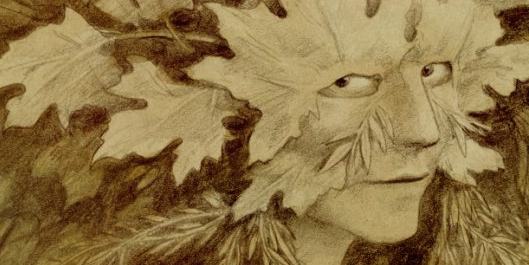 The art above is by Brian Froud, from The Land of Froud, Good Faeries/Bad Faeries, The Runes of Efland (with Ari Berk) and Trolls (with Wendy Froud). His latest book is Faeries' Tales, written and co-illustrated by Wendy Froud.
The art above is by Brian Froud, from The Land of Froud, Good Faeries/Bad Faeries, The Runes of Efland (with Ari Berk) and Trolls (with Wendy Froud). His latest book is Faeries' Tales, written and co-illustrated by Wendy Froud.
Terri Windling's Blog
- Terri Windling's profile
- 708 followers


